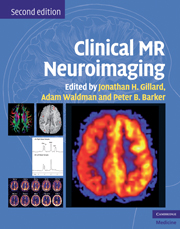Book contents
- Frontmatter
- Contents
- Contributors
- Case studies
- Preface to the second edition
- Preface to the first edition
- Abbreviations
- Introduction
- Section 1 Physiological MR techniques
- Section 2 Cerebrovascular disease
- Section 3 Adult neoplasia
- Section 4 Infection, inflammation and demyelination
- Section 5 Seizure disorders
- Section 6 Psychiatric and neurodegenerative diseases
- Chapter 36 Psychiatric and neurodegenerative disease
- Chapter 37 Magnetic resonance spectroscopy in psychiatry
- Chapter 38 Diffusion MR imaging in neuropsychiatry and aging
- Chapter 39 Proton MR spectroscopy in aging and dementia
- Chapter 40 Physiological MR in neurodegenerative diseases
- Chapter 41 Iron imaging in neurodegenerative disorders
- Section 7 Trauma
- Section 8 Pediatrics
- Section 9 The spine
- Index
- References
Chapter 41 - Iron imaging in neurodegenerative disorders
from Section 6 - Psychiatric and neurodegenerative diseases
Published online by Cambridge University Press: 05 March 2013
- Frontmatter
- Contents
- Contributors
- Case studies
- Preface to the second edition
- Preface to the first edition
- Abbreviations
- Introduction
- Section 1 Physiological MR techniques
- Section 2 Cerebrovascular disease
- Section 3 Adult neoplasia
- Section 4 Infection, inflammation and demyelination
- Section 5 Seizure disorders
- Section 6 Psychiatric and neurodegenerative diseases
- Chapter 36 Psychiatric and neurodegenerative disease
- Chapter 37 Magnetic resonance spectroscopy in psychiatry
- Chapter 38 Diffusion MR imaging in neuropsychiatry and aging
- Chapter 39 Proton MR spectroscopy in aging and dementia
- Chapter 40 Physiological MR in neurodegenerative diseases
- Chapter 41 Iron imaging in neurodegenerative disorders
- Section 7 Trauma
- Section 8 Pediatrics
- Section 9 The spine
- Index
- References
Summary
Introduction
Iron plays an important role in normal neuronal metabolism. Excessive iron is, however, considered to be harmful because of its role in causing oxidative stress. It is well established in the literature that abnormal non-heme iron deposits (in different forms) occur in neurodegenerative disorders, including Alzheimer’s disease (AD), Huntington’s disease (HD), Parkinson’s disease (PD), multiple sclerosis, and neurodegenerative brain iron accumulation (NBIA). This suggests that oxidative stress resulting from imbalance in iron regulation may contribute to the pathological cascade in these diseases. The metabolism of brain iron and its potential role in causing various neurodegenerative disorders has been discussed in detail in Moos and Morgan [1] and Berg and Youdim.[2] Iron imaging will play an important role in understanding the mechanisms and may be useful for early diagnosis of neurodegenerative disorders. This chapter has two objectives: to present the basics of iron signal detection using magnetic resonance imaging (MRI) and to examine the potential of MRI techniques for imaging abnormal iron deposits in various neurodegenerative disorders.
Iron signal in MRI
The MRI approach utilizes the nuclear magnetic resonance of atomic nuclei and, because of the abundance of protons in the human body (primarily in tissue water), MRI machines use signal from protons for imaging. The signal contrast in MR images mainly originates from differences in the proton density, longitudinal relaxation (T1) and transverse relaxation (T2) of protons in different tissues. Additionally in sequences such as gradient echo sequences where there is no 180° radiofrequency pulse to refocus the dephasing resulting from magnetic field inhomogeneity, the amplitude of the gradient echo carries a 1/T2* weighting where 1/T2* = 1/T2 + 1/T2′ where T2′ is the reversible contribution resulting from local magnetic field inhomogeneity. Since MRI detects changes in electromagnetic signals, changes in local magnetic field inhomogeneities caused by the presence of iron alter the signal contrast in the images. The presence of iron is mainly associated with reduction of T1, T2, and T2* relaxation of protons. There has been some recent work on using additional MRI contrasts such as diffusion tensor imaging (DTI) metrics and rotating frame relaxation constants, longitudinal (T1ρ) and transverse (T2ρ), to measure local iron content.
- Type
- Chapter
- Information
- Clinical MR NeuroimagingPhysiological and Functional Techniques, pp. 642 - 652Publisher: Cambridge University PressPrint publication year: 2009

